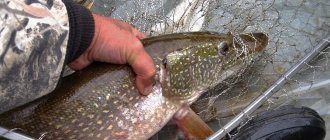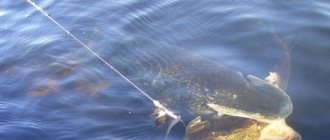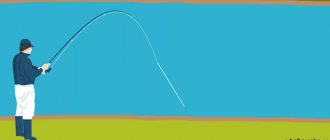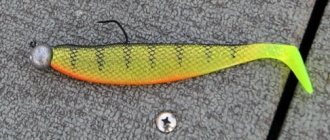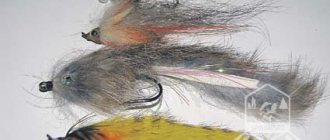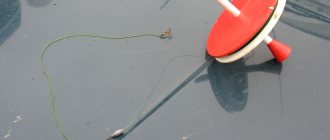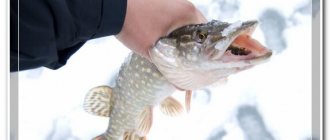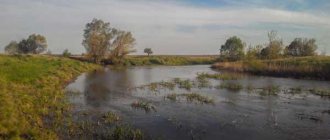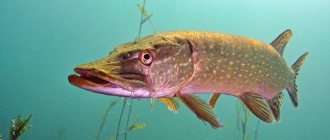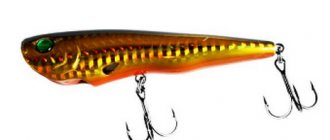Specifics of pike fishing in autumn
Autumn is a time when the air becomes cooler, as does the water, which affects all processes that occur in reservoirs. For example, with the arrival of cold weather, algae and other aquatic vegetation die off, and the water becomes much cleaner and clearer than it was in the summer. The behavior of pikes also changes.
At the beginning of autumn, when the water is warm enough, the fish are close to the surface of the water most of the time, which allows fishermen to take a large catch, since any bait can be used - be it live bait or artificial. Pike are especially active at this time, they are full of energy and therefore rush at everything they see in front of them, so this is the best time for anglers. And when the temperature drops significantly, the pike goes to a depth that is more comfortable for it.
Less effective and more difficult is catching pike in late autumn, when the first frosts begin and the water is covered with thin ice. It significantly reduces visibility, which creates additional difficulties and inconvenience for fishermen.
Rules for catching pike from a boat
You can catch pike in June from a boat using the same equipment as when fishing from the shore. Spinning, mugs, vertical fishing, and trolling methods are actively used.
Plumb fishing
When fishing vertically, it is recommended to use an echo sounder first. Vibrating tails or wobblers equipped with rattles can be used as attachments.
Trolling
Trolling is fishing from a boat while it is moving. In this case, it is necessary to wire the bait and use an echo sounder. The trolling boat must be plastic and equipped with a 9-15 horsepower motor. The boat speed for trolling should be about 2 km/h.
Fishing with mugs
Catching pike in June from a boat with mugs is the most interesting. This fishing method is reminiscent of hunting, since fishing is done with live bait and there is a need to use a cage. The one who is faster wins! In addition to the listed equipment, you will need a “cavalry”, a mechanism for supplying air to live bait, leashes, weights and hooks.
Habitats of pike in autumn
Pike, like other fish species, have individual behavioral characteristics that can vary depending on the body of water, as well as taste preferences. Since this is a predatory fish, it needs to hunt someone, but in the fall the pike prefers to do this not openly, chasing prey, but watching it from ambush in order to pounce at an opportune moment. To do this, the fish always chooses some kind of shelter.
Most often, while the water is not yet too cold, the pike hides near the places of the greatest concentration of fry and small fish, for example, in the grass or reeds. By observing their behavior, experienced fishermen can accurately determine where the pike is hiding and behave as quietly as possible so as not to inadvertently scare it away as it swims past. And the lower the water temperature, the deeper the small fish go, to where the pike is already waiting for it, because that is its native habitat.
If pike fishing in late autumn is carried out from the shore, then you need to look for areas where there are snags, algae, tufts of grass, and underwater spits. It must be remembered that pike are not found where there is a river current, so an area with a reverse flow (but no closer than 50 meters from the main current) can become a place for successful fishing.
As soon as algae and other vegetation in the water begin to die off, you can approach those places that were previously inaccessible, since the fish there feel safe and can go for any bait.
Where does a pike stand in troubled water?
A pike in muddy water tries to occupy a place in order to somehow protect itself from the dirt suspended in the water. Pike does not stand near the shore and does not stand in the current; it chooses areas with low pressure that form behind underwater obstacles.
Or the predator chooses areas on the border between forward and reverse flows. Fishermen can often see that between two jets, forward and backward, a so-called “eye” is often formed - an oval area of relatively clear water.
At these moments, the pike tries not to move unnecessarily. You will not see such movements as the predator sometimes makes in clear autumn water or in clear water before high water. First of all, the fish is worth it. And secondly, the water is so cloudy that you can’t see anything!
Pike attacks at this moment are short. The predator attacks no further than the length of its body. However, at this moment the white fish also tries to stay in the same places that the predator chooses for itself.
And this means that the pike has absolutely no need to make long movements, because the food fish is constantly scurrying in front of its very nose.
What gear is best to use for pike fishing in the fall?
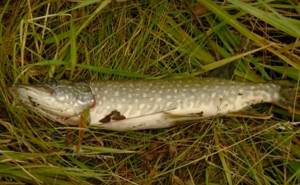
- Spinning . At the beginning of autumn, you can catch more fish using a spinning rod than using any other gear. If you arrange fishing during the period of the most active feeding, then you can use any bait, and the larger the bait, the faster the pike will bite. But when choosing a spinning rod, it is worth taking into account the weight of the fish that the angler plans to catch and the tactics of retrieving. In order not to spook the fish, it is better to take wobblers that are not of bright colors, and choose a spinner that is not too large. When choosing a spinning reel, you need to take into account its quality, as well as its compliance with the action of the rod and its class. The correct diameter of the fishing line can be determined by the method of guiding the bait that the fisherman chose.
- Jig . One of the effective types of fishing is jig fishing. A fast-action spinning rod with a length of up to 2.7 meters is suitable here. It is important that the tip be such that you can feel the behavior of the bait on the bottom, since this is very important with this method of fishing. It is also necessary to ensure that the size of the reel is selected correctly, and that the cord or fishing line is wound well to avoid tangling during use. In this case, the diameter of the fishing line can be from 0.13 to 0.25 mm. If you take a little more, then this will have an insignificant effect on the casting distance, but it will help if the tackle gets caught on something, for example, on snags.
- Mugs. To catch pike with mugs, you do not need to buy expensive reels or rods; this method can be called budgetary, but no less effective, which is why it has become very popular recently. You can assemble the mugs yourself. It is necessary to take spools of polystyrene foam with a large diameter and wind a fishing line on them (10 to 20 meters long) with a cross-section of 0.30-0.35 mm. The weight of the sinker is adjusted depending on the size and mobility of the baitfish. To catch active pike, drifting mugs are suitable, but for passive fish you should use a tethered mug. This is when the baitfish on the hook makes chaotic movements, attracting the attention of the predator and causing its aggression. With this method of fishing, success can be achieved even on small lakes if the pike feeds in the coastal zone.
- Donka . Catching pike with a donk can be called unmodern and unsporting. However, this type of fishing, especially when you go out purposefully to catch a toothy fish, is no different in simplicity. Knowledge and experience are also required here.
WHERE and HOW to catch TROPHY pike in late autumn in clear water
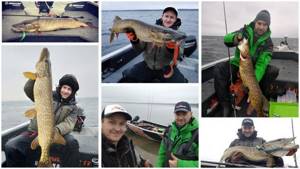
Catching trophy pike is not an easy task. Especially on such a huge lake as Naroch. And the question here is not so much what to catch, but rather where and how. If everything is more or less clear with baits and tackle, I already paid attention to them in previous videos, then with fishing techniques and tactics, not everything is so clear. At different times of the year, large pike adhere to different habitats. If in summer and early autumn it can stay in relatively shallow areas of the reservoir and can be caught in the upper areas at 4-5 meters, then with the water cooling, I would say from 10-12 degrees and below, the pike descends to deeper places and the main working depths are the lower boundaries of dumps from 7 to 12-14 meters. And this is largely due to the presence of forage fish (perch). In late autumn you almost never see it in the upper areas of the cans. It gathers in huge flocks and stays mainly on the lower borders of the cans. In addition, these huge flocks of small fish move very actively, and sometimes searching for food can take most of the time. You can swim across a huge section of a reservoir, check dozens of cans and not see any fish at all in the echo sounder. But then somewhere you come across a jar filled with “minced meat” and... This is one of the main principles of searching for pike in the late autumn period - the main thing is to find the maximum accumulation of small things.
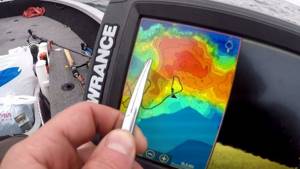
So, you found a fish, but how to catch it, or rather, catch it? There are also plenty of subtleties here. Firstly, how to anchor properly? Whether you fish from an anchor or use a motor guide, the main thing here is not to make noise and not hit the pike on the head with the anchor. Of course, this is a controversial issue, but we have already noticed more than once that large pike do not allow one to get close to them, and their bites usually happen at a distant throw. Therefore, you need to anchor at a considerable distance from the intended fishing area. Whether you stand at the top of the can or at the bottom, depending on the wind, does not matter. The main thing is to keep your distance. If your boat is equipped with a motor guide, then even better. Approach the fishing spot or move around the bank, preferably using an electric motor, turning off the main engine. Thus, the chances of biting a trophy increase.
Don’t forget about the main, so to speak, sporting rule - searching for active fish. Be that as it may, pike, especially large ones, feed on hatches, and they can occur at different times of the day. Therefore, there is no point in staying at anchor for a long time. Fishing with two people in a boat, it is enough for each person to make three casts to detect the presence of an active predator. If no bites have occurred at the moment, then you can return to this area at another time, especially if the fish have not moved anywhere from here.
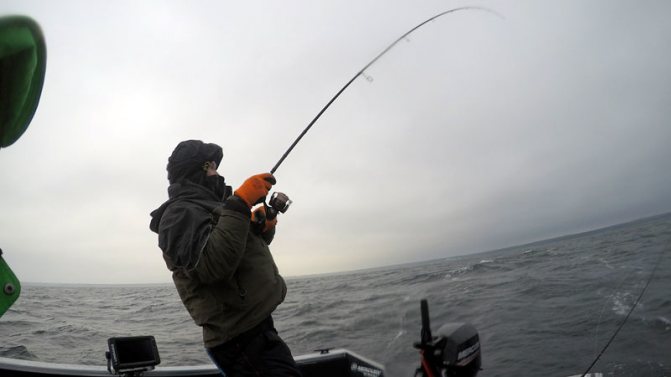
An important point is how to properly present our bait. An echo sounder will help us a lot here. If the pike is active, then, as a rule, it is clearly visible on the downscan. It clearly hangs close to a flock of small fish, and this is already a good sign. In most cases, this means that the pike is in the mood and will react to your bait from a greater distance. Therefore, there is no point in trying to guide the bait along the very bottom and distort with speed and animation. When the echo sounder is “silent” and the pike is practically not visible, and if it is visible, then it literally creeps along the bottom, then the calico is different. You need to try to deepen the bait as much as possible and try to lead it closer to the bottom, pausing, twitching and constantly changing the speed of the retrieve.
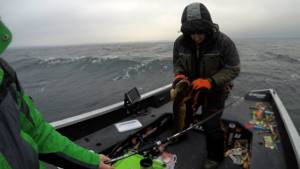
And of course, don’t forget about the weather. It is best when the weather is more or less stable, there are no sudden changes in pressure and the wind blows in a constant direction. As practice has shown, the more wind, the better. And the bait flies further, and the pike is not so careful. Also the bite was much better in cloudy weather. In short, the worse it is for us, the better it is for the fish. And if it’s calm and the sun is shining, then it’s better to spend this time on the shore with a fire and barbecue.
Video we share secrets about WHERE and HOW to catch TROPHY pike in late autumn (October, November, December, January) in clear water on Lake Naroch, Belarus. Searching, pinpointing what gear and bait are needed so that the long-awaited trophy ends up in your boat.
Varieties of autumn lures for pike fishing
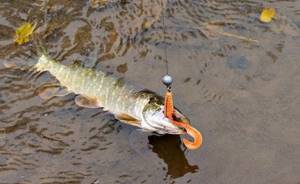
The most affordable way to get a good catch is to catch pike with live bait. Here you can even do without expensive gear, the main thing is to have a high-quality and reliable hook, as well as a strong leash. Roach, minnows or small crucian carp are the best live bait. Sometimes they also use ruffs, but they can scare away the pike with their spiny fins. You should not use too large or very small fish as live bait. And if you have the opportunity to choose, then preference should be given to those live bait that will be mobile longer after being hooked. To make the bait as realistic as possible, it should be put on the hooks through the gills or lips and nostril, and not just through the fin.
In addition to live bait, there is another type of bait - spinners. For pike fishing, this is exactly the gear with which you can get a big catch, you just need to know how to handle it correctly. Spoons are made of copper and tin, but for catching pike in the fall, copper is suitable, as it is light, and it is better not to use tin - it falls off too quickly.
It is in the fall that spinners will be the most effective means for pike fishing. The most catch can be obtained using rotating spoons, but only at a depth of no more than 3 meters. Oscillating spinners can also give good results, which are suitable for those who are not lazy to constantly work with the reel (if they are large and heavy, then it is best to use them before the onset of persistent cold weather). In addition, balancers and castmasters can be used - pike also go well on them.
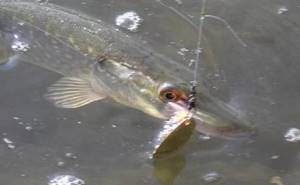
There is another type of bait for effective pike fishing in late autumn - wobblers. This is a plastic fish equipped with treble hooks. In the water, such a bait moves due to the jerks of the rod made by the angler, and the reel only affects the tension of the fishing line. In clear water and in sunny weather it is better to use wobblers of matte colors, and on cloudy days - bright ones. Dark ones are suitable if the water is cool. In addition, you need to take into account the fact that wobblers come in three types of buoyancy: floating, sinking and neutral (suspenders).
Things to remember when fishing for pike in autumn
A fisherman who decides to fish for pike from September to November should first decide what kind of fish he will go for - active or calm. If the first option is chosen, then the bait must be long-range. This includes wobblers, oscillating spoons and silicone baits. They allow wiring along the bottom and in different parts of the reservoir.
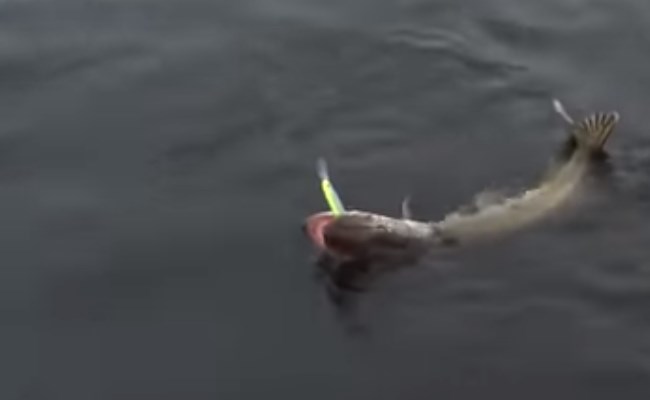
Weather conditions affect the behavior of pike in autumn. If the day is cloudy, it can look for food in the shallows, and in sunny weather it can go deeper. When going on stationary fishing, you should not throw away your gear before you have found the place where the fish are most likely to be found.
Pike fishing in May
The division of spring pike fishing into March, April and May is very arbitrary. The rate of warming changes from year to year - naturally, the biorhythms of fish and their life activity in the reservoir directly depend on this. The article on March pike fishing discusses in detail how to catch the pre-spawning zhor in the period before the flood, from the melting of ice in clean cold water.
Sometimes spring comes into full swing already in April - as in the southern regions, where the post-spawning feast occurs already at the end of this month. In some places, it is possible to catch toothfish even in high water - selectively, in relatively clean bays and ponds, where the water does not rise strongly and does not become cloudy. Read more about pike fishing in April. Here we will consider the last spring stage, pike fishing in May - when the predator has already spawned, everywhere is quickly warming up and turning green, summer is approaching.
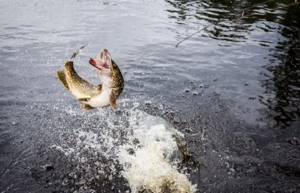
Therefore, it is impossible to say unambiguously, without reference to climate and region, when pike starts biting in May. It all depends on the specific area. Therefore, we will rely not on calendar dates, but on natural changes. There is even such a science as phenology, which studies natural relationships (phenoindicators) in time relative to each other. In simple terms - folk signs. In our case, the pike bite in May stabilizes during the rose hips flowering, and begins when dandelions and swimsuits bloom, and quails begin to sing mating songs in the fields. This is much more reliable than incomprehensible biting calendars - you can’t fool nature.

Tips for anglers
1) In autumn it is easier to catch large pike, so it is better to use strong gear.
2) Lures are important. They should be easy to carry out at different depths, and the choice of color should be guided by the weather.
3) Water temperature. If, while fishing for pike in late autumn, it drops below +10, then baits should be taken with weak action or without it at all.
4) It is more likely to catch pike with live bait in the “warm water” of early autumn, and in colder, late autumn, it is better to use other baits.
Author Denis Buzak
